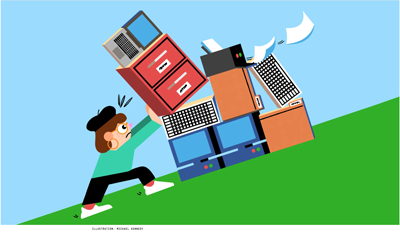
There are a host of reasons why our work hours continue to climb, even before the pandemic blurred the lines between work and non-work hours. One of the many culprits is the time we now spend on administrative work that we didn’t used to. Why is that?
“40 percent of administrative assistant roles disappeared between 2000 and 2020, a number comparable to manufacturing job losses. And that was before the pandemic, which caused massive cost cuts at a huge number of companies, but whose lasting effects aren’t yet visible in federal data.”1
My guess is that there is a belief that technology is going to “take care” of this administrative work from management’s viewpoint. Regardless, the second order effect of these cuts means those roles that remain, have to absorb this administrative work, without any changes, recognition or remuneration.
“But that means senior staff are doing more and more administrative work. I'm not saying this is beneath us; admin work is crucial. It's just that doing the tasks we were hired for, which can help the company’s bottom line, gets sidelined or pushed to evening and weekend hours. Is there any way to combat this trend?”
As usual, when management practices like cost-cutting are deployed without serious scrutiny, the ones who pay the price are the people left standing. If you are a conscientious high-performer, you shoulder this increased burden, work longer hours and pay the personal cost. The company doesn’t suffer in the short-term.
“ Productivity growth is the most important single driver of higher living standards, and technological progress is the primary engine of productivity growth. Thus, it is troubling that despite impressive advances in AI and digital technologies, measured productivity growth has slowed since 2005.
While there are many reasons for this, the most important is that technological advances typically don’t translate into improvements in productivity unless and until complementary innovations are developed. These include many intangible assets such as new business processes, business models, skills, techniques, and organizational cultures. The need for myriad complementary innovations is substantial, especially in the case of fundamental technology advancements such as AI. Yet, these complementary innovations can take years or even decades to create and implement; in the meantime, measured productivity growth can fall below trends as real resources are devoted to investments in these innovations. Eventually, productivity growth not only returns to normal but even exceeds its previous rates. This pattern is called a Productivity J-Curve.”2
If companies don’t take more holistic view of the real drivers of productivity, and how technology is actually used in the workplace, employees will continue to pay the price. A good first step would be for managers to understand what exactly employees are spending their time on, and how (or if) these actions are directly connected to the processes that are required to sustain or build their value proposition and competitive advantage? In short, why is anyone spending time on administration unless it is directly driving our ability to serve our customers or to build new capabilities to do so?
In 1978, Peter Drucker wrote,
“To make knowledge work productive will be the great management task of this century, just as to make manual work productive was the great management task of the last century.”
We don’t seem to have made much progress on this front.
-
https://www.wired.com/story/help-im-drowning-in-admin-and-cant-get-my-actual-job-done/
-
Understanding and Addressing the Modern Productivity Paradox Erik Brynjolfsson, Seth Benzell, and Daniel Rock http://ccs.mit.edu/papers/CCSWP130/CCSWP130.html
